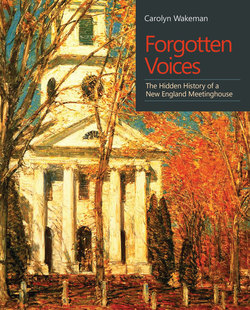Читать книгу Forgotten Voices - Carolyn Wakeman - Страница 9
На сайте Литреса книга снята с продажи.
ОглавлениеCHAPTER TWO
Debate and Delay
Deliberation about location, materials, and funding delayed completion of Lyme’s second meetinghouse. Initially expected to take twelve months, the project required twelve years.
And concerning placing the meeting house that it be left to be determined by the General Court in May next and that either side shall have a deputy to prefer and allege the same into said court.
Lyme’s population had doubled when inhabitants agreed in 1680 to replace the original meetinghouse. That effort began when Joseph Peck (1641–1718), Edward DeWolfe (1646–1712), and Richard Lord (1647–1727) agreed “to provide and saw all the timber for the frame of such a meeting house as shall be concluded to be built by the town between this and Michaelmas next, twelve months.” As compensation the town offered the privilege of cutting timber from common land and permission to operate a sawmill on what would later be called the Eight Mile River. Given the growing scarcity of timber and the demand for barrel staves for sugar plantations in the West Indies, the arrangement offered mutual benefits.
Three years passed before residents agreed in 1683/4 that the dimensions of the proposed meetinghouse “shall be 40 foot long and 26 foot wide and 14½ foot between joints.” Plans moved forward again in 1685 when the town offered twenty-two acres of upland to sawmill owner Edward DeWolfe in return for his providing boards and eighteen-inch chestnut or cedar shingles “to cover the meetinghouse which is to be built.” Disagreement over the site then stalled the project. At the town’s request, the General Court agreed to resolve the dispute and sent two representatives to Lyme to hear opposing opinions.
Wolston Brockway, an early settler whose property adjoined the site of the original meetinghouse, testified to Lyme’s deputy Matthew Griswold that the replacement should occupy the place previously decided. “Before Lyme meeting house was built,” Brockway recalled, “the place that the inhabitants agreed upon and accordingly staked out for to set our meeting house upon was on a hill just above Richard Smith’s [1620–1682] his now dwelling house.” But “not long after the first place was staked out,” Brockway’s “uncle Waller” informed him that “the stakes for the meeting house overlapped slightly” on his own land. Brockway then “protested against the standing of the meeting house on the aforesaid place,” and William Waller, formerly a town constable and representative to the General Court, “carted the timber unto the place where the meeting house now standeth.” The Court, siding with Brockway, decided that the original hillside location of the meetinghouse should not change.
After joining the landscape painters gathered in Old Lyme in 1903, New York artist Edward Rook painted eight different impressions of the repurposed mill on the site of the town’s first gristmill built in 1678.
While discussions of “what will be needful for the finishing of the meeting house” continued, Lyme’s inhabitants attended to other needs. They measured, surveyed, and allocated whatever land had not been distributed. They built roads, bridges, fences, livestock pounds, and public landings. They exported barrel staves and imported “salt and Barbados goods on reasonable terms.” They authorized the building of a warehouse whose owner would “supply the town of Lyme with salt and certain woods upon reasonable terms,” and they prohibited the cutting of timber on common land and the “transport of the same out of the town” because “all sorts of timber grow scarce among us.” They also managed the operation of the gristmill to keep it “in repair continually for to grind the town’s corn all winter and summer,” and they decided the length of the school year, authorizing two dame schools “for teaching young children and maids to read and whatever else they may be capable of learning, either knitting or sewing.” In 1685 they decided to erect “a pair of stocks & scaffold to answer the laws within a month at the meeting house.”
Weathered headstones in a cemetery on Meetinghouse Hill recall the names of early colonists who settled in the area called Between the Rivers. Today a country club and golf course occupy the former site of Sabbath meetings.
Work on the town’s public building resumed after a decision in 1687 to “take care of the meetinghouse timber & to procure the meeting house perfectly finished.” Authorization to purchase boards and timbers for “the seating and the sealing of the meetinghouse with all speed” came a year later, and approval in 1690 to raise the pulpit brought the project near completion. A controversy about whether to pay for seats with a special tax or by selling common land then required three separate votes. The interior seating had apparently been completed two years later when a town meeting in April 1692 required that “all bachelors and boys from eight years old and upwards shall be catechized by Mr. Noyes once a fortnight on the Lords day in the meetinghouse.” On weekdays “all maids and girls” would be catechized “as Mr. Noyes shall see meet to order.”
A granite marker placed on Meetinghouse Hill by postmaster Benjamin Franklin’s survey team in 1753 gave the distance between Lyme and the active customs port of New London as fourteen miles.
